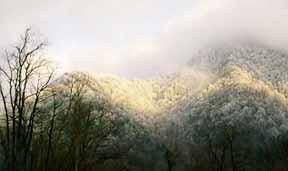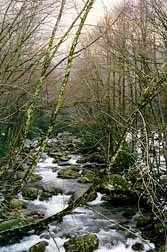 Heaven Can Wait The timeless terrain of the Smokies screams eternity, but there's more exploring to do. Introduction by Glynn Wilson  Photos by Ron Sitton
Photos by Ron SittonThe Southland is rich in secret vistas — little-known places that touch the heart and stir the spirit. Secluded Gulf of Mexico beaches in the off season. Quiet Appalachian hiking trails and glistening streams thick with trout. Hidden forests with trees dating back to Christopher Columbus. Pools and caves alive with the spirit of Cherokee medicine. Little-known views as stunning as anything in the North or West. Sometimes it's not just the setting, but the time or season making a scene special. Wild flowers in a meadow in spring. An albino fawn feeding streamside, spotted through the mists of a summer dawn. The Monarch butterfly migration on the Gulf Coast in late fall. A camp site in the Great Smoky Mountains National Park on a winter morning, with just a light dusting of snow, the clouds hanging low in the spruce fir. You don't go out looking for vistas that will haunt you forever, but sometimes you find them. Especially if you live or spend time in the South. Everyone should know a special place like this in nature. Some of us with a heightened sense of biophilia know many. This is probably more important for mental and physical health in modern society than the strongest of perscription drugs or annual checkups. Here we share a select few of these with the rest of the world, knowing full well most people will never actually disturb the places. But they are always in search of somewhere to go, many for this inner fulfillment. Why do 10 million people visit the Great Smoky Mountains National Park every year, for instance? To view the scenery, say 95 percent of visitors surveyed by the National Park Service, especially in the fall. To see what others have seen and, perhaps, something that no one else has noticed. To marvel at nature's bounty and to mentally relax. This urge is endemic to the human spirit and predates the last ice age 10,000 years ago. But since the dawn of the industrial age, the longing to escape cityscapes for natural landscapes has grown more desperate as greenspaces give way to sprawling development. Perhaps we are losing this sense. Many seem content to read about these places or to view them through the television or computer screen. Our readers, I suspect, like to read about these special places AND experience them. That is what this monthly feature is all about, in addition to what admirers of Eudora Welty, William Faulkner and Tennessee Williams liked to call a "sense of place." We suspect our readers will help us make these connections over the next few months. The idea has to do with the historical development of our society on one hand and our evolutionary past on the other. That is, industrial development patterns and the crossroads of the nature verses nurture debate. Many of these places are not really all that secret. But they are special in Mother Nature's locale, and timing is sometimes critical. We open with a piece by Donovan Webster. Please feel free to let us in on your secret vistas. We will run them in this space or in the Discourse department. Bon Voyage. GW The West Prong and Beyond  A recent park service study concluded that one-sixth of the nine million-plus yearly visitors to Great Smoky Mountains National Park never dawdle long enough even to turn off their engines — making it laughably simple to escape the hordes. Just get out of the car, start down any of the park's more than 850 miles of hiking trails, and within a mile or two you'll be strutting through your own private Ida ... er, Appalachia.
A recent park service study concluded that one-sixth of the nine million-plus yearly visitors to Great Smoky Mountains National Park never dawdle long enough even to turn off their engines — making it laughably simple to escape the hordes. Just get out of the car, start down any of the park's more than 850 miles of hiking trails, and within a mile or two you'll be strutting through your own private Ida ... er, Appalachia.
By Donovan Webster The first time I saw the place where my ashes will someday be scattered, I was 11 years old. My family was in the midst of a road trip from Chicago to Florida, and things were going badly. My teenage sister had left her clothes in a hotel closet, while my little brother and I were continuing our longtime bait-n-punch relationship in the backseat. Finally my father met his limit. In Gatlinburg, Tenn., he disappeared, returning with a bag of groceries. He piled us into our Buick, drove a few miles past the entrance to Great Smoky Mountains National Park and parked the car at a turnout. Then he led us off for a picnic along what I later learned was the West Prong of the Little Pigeon River, its banks only a steep quarter-mile beyond the highway's shoulders. That lunch turned the trip around. We played in the water, throwing rocks and spying trout, until my parents herded us back into the car at sunset. Sibling relations stayed blessedly tranquil all the way to Florida. At the time, I made a silent vow: Someday I would live near that stream. And I did, too, for six weeks in 1989, fishing the West Prong almost daily. But by then I'd already been catching trout in the river for years, always in total solitude. Over three decades, as I slept beside the Little Pigeon, had showdowns with snakes and bears, and took my share of fish from its shallow pools, I saw only one other person: a Japanese tourist, apparently lost, and carrying a video camera — the better, no doubt, to capture those fast-moving mountains. I always feel sorry for visitors who rush through the Smokies. If they'd leave their cars, they'd find tranquil wilderness. Here in the shadow of Mount LeConte, the poplars and spruces rise hundreds of feet into the sky, and mist rises from the damp, mushroom-strewn earth. It's like fishing inside a terrarium. And the fish are there with a vengeance. Down low, at the mountain's base, there are brown trout and rainbows. Up higher, where the creek grows narrower and steeper, the browns disappear and the rainbows are smaller but more aggressive. When you get one to hand, it's solid and cold — like a little brick — and it almost thrums with low-level electric current. I don't know when it first hit me that the West Prong was where I wanted my ashes scattered. Probably the same time I found the ruins of a few pre-1900 homesteads along the river. Coming on those low stone walls now overgrown by moss, I had a sense of placid eternity. Each time I see them, I'm reminded that not everything is urgent, that silence and deliberation have their place. Last spring, my wife and I took our kids to the West Prong for their first picnic there. I brought my fishing gear but didn't use it. The kids were skipping stones, spooking the trout. So I shrugged and chunked some stones myself. We kept at it for hours, our feet in the cool water, my mind on the sometimes beautiful circularity of life and on the knowledge that the last favor these people I love will do for me is bring me to this place I love. Strange as it sounds, I was smiling.  [Donovan Webster's Aftermath: The Remnants of War was recently released in paperback by Vintage Books. He is a contributor to Outside magazine, where a version of this feature first appeared, and he was Managing Editor of Southern Magazine,1986-1989]. Back to Contents Copyright © The Southerner 1999. Thanks to Donovan Webster. Photos by Ron Sitton. 

|
